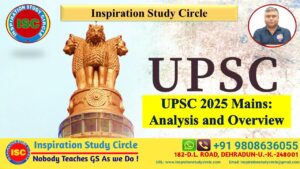
UPSC Mains 2025 Analysis and Overview
UPSC Mains 2025 Analysis and Overview Table of Contents The UPSC Mains 2025 analysis indicated a paper that was a balance of static and analytical questions,
High-level meetings with a three-part focus marked Prime Minister Narendra Modi’s three-day visit to the U.S. He spent one day at the Quad and in bilateral discussions with U.S. President Joseph Biden, a day in New York with business leaders and the diaspora, and another day at the UN and in bilateral meetings. The Quad Summit, delayed due to political cycles in the four member countries, was more substantive than expected for a farewell meeting (Mr. Biden and Japan’s Fumio Kishida will soon demit office).
During his trip, he attended the Quad Leaders’ Summit in Wilmington on September 21, addressed thousands of members of the Indian American community in Long Island on September 22, and spoke at the UN’s Summit of the Future on Monday.
The prime minister engaged in bilateral discussions with world leaders and held a roundtable with CEOs from leading American tech companies.
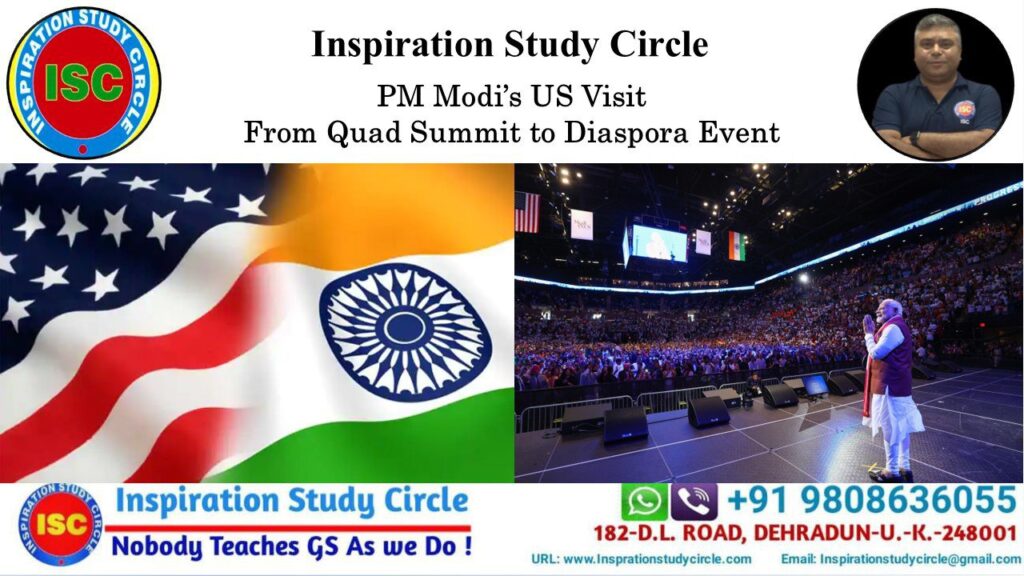
On Day 1 of his US visit, Prime Minister Modi attended the Quad Summit hosted by President Joe Biden in Wilmington, Delaware. The summit was also attended by Australian Prime Minister Anthony Albanese and Japanese Prime Minister Fumio Kishida.
Modi noted that the Quad leaders gathered during a time of global tensions, emphasizing that their collaboration is important for all of humanity.
Highlighting that they are “not against anyone” he said that they support a rules-based international order, respect for sovereignty, and the peaceful resolution of disputes. This was seen as a subtle reference to China’s assertive actions in the Indo-Pacific region. The final declaration of Quad included stronger language regarding the South China Sea than in previous versions.
The summit featured a bilateral meeting between Modi and Biden, who remarked that the partnership between the United States and India is “stronger, closer, and more dynamic than ever”.
Both the leaders hailed a significant agreement to establish a new semiconductor fabrication plant in India, supported by the India Semiconductor Mission and a strategic partnership involving Bharat Semi, 3rdiTech, and the US Space Force.
The Quad leaders also announced the Quad Cancer Moonshot, a partnership aimed at initially combating cervical cancer in the Indo-Pacific, with plans to address other types of cancer in the future.
Additionally, the US handed over 297 antiquities, smuggled out of India, to Modi during his visit, as confirmed by Foreign Secretary Vikram Misri. He also noted that issues related to Bangladesh were discussed in the meeting between Modi and Biden.
PM Modi addressed a gathering of over 13,000 Indian Americans, with many attendees hailing from the New York and New Jersey area, while others traveled from 40 states across the country. Organizers reported that sixty chartered buses were used for transportation.
Describing India as a “land of opportunities”, Modi shared his ambitious goals for the nation during his third term.
Modi also announced the opening of two new consulates in Boston and Los Angeles, addressing a long-standing demand from the rapidly growing Indian American community in these major cities.
The prime minister emphasised India’s foreign policy of fostering equal closeness with all nations, rather than maintaining equal distance.
Recognizing the vital role of Indian Americans in strengthening ties between India and the United States, he referred to them as India’s brand ambassadors.
On the last day of his US visit, Prime Minister Modi addressed the UN’s Summit of the Future in New York. He began his speech with a namaskar, emphasizing that he represents the voice of 1.4 billion Indians, or one-sixth of humanity.
“Success of humanity lies in our collective strength, not on the battlefield,” Modi stated, highlighting the urgent need for global cooperation amid ongoing conflicts like those in Israel-Gaza and Ukraine.
Modi stressed that reform is essential for the relevance of global institutions and pointed out that the inclusion of the African Union as a permanent G20 member during India’s presidency was a significant step in this direction.
Semiconductor Supply Chains – A MoU on Semiconductor Supply Chain and Innovation Partnership was signed among the nations.
Critical Minerals – India has become the latest accomplice of the U.S.’s Minerals Security Partnership (MSP) to diversify and steady essential mineral supply chains.
Telecommunications – India and the US released public-private Joint Task Forces. India’s Bharat 6G and the U.S. Next G Alliance will co-lead this public-non-public research.
Space – India has signed the Artemis Accords, a common vision of space exploration for the gain of all humankind.
Quantum tech – A Joint Quantum Coordination Mechanism becomes hooked up to facilitate joint studies among the private and non-private sectors across each country.
ICET – ‘Innovation Handshake’, an industrial Dialogue might be launched to attach every U.S.’s begin-up ecosystems, supporting the U.S.-India Initiative on Critical and Emerging Technology (iCET).
Civil Aviation – Air India strike a historic agreement with Boeing to accumulate more than 200 American-made planes.
Defense – The India-U.S. Defence Acceleration Ecosystem (INDUS-X) turned into an inaugurated joint innovation on defense technology integrating India’s non-public defense enterprise.
Student Exchange – Launched a new Joint Task Force of the Association of American Universities and main Indian instructional establishments, together with the Indian Institutes of Technology.
Research – Launched a college community of Indo-U.S. Global Challenge Institutes to help create more studies partnerships and exchanges in agriculture, power, fitness, and era.
Energy – USAID signed an MOU with the Ministry of Railways to work together on Indian Railways’ goal to end up a “net-0” carbon emitter by 2030. India and the USA are dedicated to growing modern investment systems for Green Technology.
Medicine – The U.S. National Cancer Institute via two new offers to broaden a synthetic-intelligence (AI)-enabled virtual pathology platform.
Prime Minister Narendra Modi’s three-day state visit to the US had a significant impact on India’s global standing. It emphasizes the country’s dual identity as a spiritual democracy and an economic powerhouse. The visit showcased India’s cultural heritage, diplomatic prowess, and growing influence on the world stage. The bilateral meeting between the two sides yielded several strategic outcomes for India in the fields of new technology, space, energy, and defense. It has strengthened bilateral relations between India and the US.

UPSC Mains 2025 Analysis and Overview Table of Contents The UPSC Mains 2025 analysis indicated a paper that was a balance of static and analytical questions,
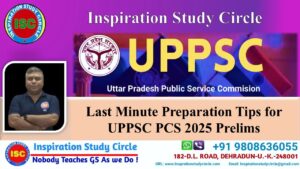
Last Minute Preparation Tips for UP PCS Prelims 2025 Table of Contents The Uttar Pradesh Public Service Commission conducts a series of annual examinations for
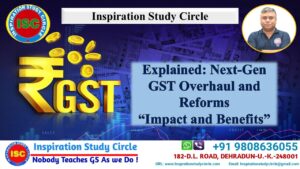
Explained: Next-Gen GST Overhaul and Reforms Table of Contents The GST Council in its 56th meeting on 3rd September, 2025, made the recommendations relating to changes in

Explained: Vikram-32 Chip Table of Contents Union Information and Broadcasting Minister Ashwini Vaishnaw recently unveiled India’s first indigenously developed 32-bit processor called VIKRAM-32. The minister presented the

UPSC Prelims 2026 Test Series Table of Contents Inspiration Study CircleUPSC Prelims 2026 Test Series The Union Public Service Commission (UPSC) is set to conduct
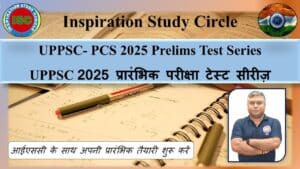
UPPSC- PCS 2025 Prelims Test Series UPPSC 2025 प्रारंभिक परीक्षा टेस्ट सीरीज़ उत्तर प्रदेश लोक सिविल सेवा 12 अक्टूबर 2025 को अपनी उच्च और संयुक्त